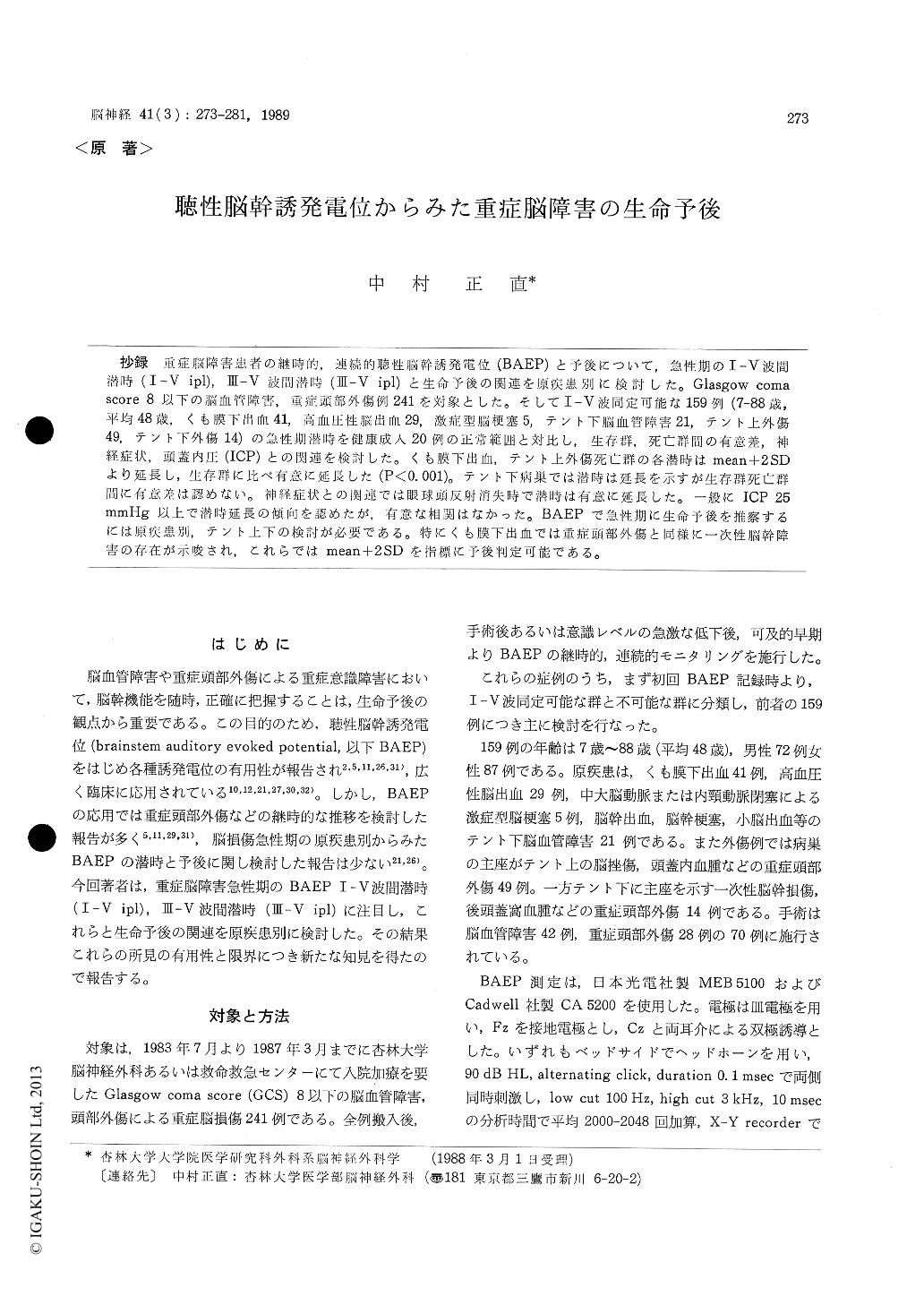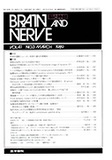Japanese
English
- 有料閲覧
- Abstract 文献概要
- 1ページ目 Look Inside
抄録 重症脳障害患者の継時的,連続的聴性脳幹誘発電位(BAEP)と予後について,急性期のI-V波間潜時(I-V ipl),III-V波間潜時(III-V ipl)と生命予後の関連を原疾患別に検討した。Glasgow comascore 8以下の脳血管障害,重症頭部外傷例241を対象とした。そしてI-V波同定可能な159例(7-88歳,平均48歳.くも膜下出血41,高血圧性脳出血29,激症型脳梗塞5,テント下脳血管障害21,テント上外傷49,テント下外傷14)の急性期潜時を健康成人20例の正常範囲と対比し。生存群,死亡群間の有意差,神経症状,頭蓋内圧(ICP)との関連を検討した。くも膜下出血,テント上外傷死亡群の各潜時はmean十2SDより延長し,生存群に比べ有意に延長した(P<0.001)。テント下病巣では潜時は延長を示すが生存群死亡群間に有意差は認めない。神経症状との関連では眼球頭反射消失時で潜時は有意に延長した。一般にICP 25mmHg以上で潜時延長の傾向を認めたが,有意な相関はなかった。BAEPで急性期に生命予後を推察するには原疾患別,テント上下の検討が必要である。特にくも膜下出血では重症頭部外傷と同様に一次性脳幹障害の存在が示唆され,これらではmean+2SDを指標に予後判定可能である。
Auditory brainstem evoked potentials (BAEPs) reflect activities of the brainstem auditory pathway and the influence of activities of structures sur-rounding the pathway. It is said that BAEPs are reliable in predicting the outcome of patients with severe brain damage. The author studied the relationship between initial BAEP findings, parti-cularly interpeak latencies of waves I to V and waves Ill to V, and mortality as based on the cause of each disorder.
BAEPs were sequentially recorded in 241 cases of various neurological diseases resulting in severe brain damage (GCS<8) during the first few days after onset.
BAEPs were graded into four groups based on initial findings. Group A : all waves I to V were recorded (159 cases). Group B: waves N & V absent (11 cases). Group C: either wave I orwaves I & If only were recorded (28 cases), Group D : all waves absent. Prognosis in Group B & C was poor, only two patients surviving in a vagetative state. There were no survivors in Group D.
The relationship in Group A between interpeak latencies (I-V ipl,III-V ipl) and prognosis is discussed. This group consisted of 41 cases sub-arachnoid hemorrhage, 29 cases hypertensive intra-cerebral hemorrhage, 5 cases severe cerebral infarc-tion, 21 cases infratentorial cerebral vascular disease, 49 cases supratentorial severe head injury, and 14 cases infratentorial head injury.
In deceased cases of subarachnoid hemorrhage and supratentorial head injury, there was signifi-cant prolongation of I-V ipl and III-V ipl over the mean latency of 20 normal subjects plus 2SD. The difference in initial BAEP findings between the deceased and survivors was significant (P< 0.001). I reasoned that subarachnoid hemorrhage cases received primary brainstem damage similar to that of head injury cases and that poor prog-nosis could be predicted by initial BAEP findings. On the other hand, there was no significantdifference between prognosis and initial BAEP findings in cases of hypertensive intracerebral hemorrhage and severe cerebral infarction. In both deceased and surviving cases of infratentorial lesions, there was longer than normal interpeak latencies, and there was no difference in initial BAEP findings. It therefore is difficult in such cases to estimate prognosis on the basis of BAEP interpeak latencies.
In the relationship between neurological signs and interpeak latencies, the prolongation of latency was mainly related to the disappearance of oculo-cephalic response.
We carried out ICP monitoring in 51 cases but there was no significant relationship between mean ICP and interpeak latencies.
BAEPs monitoring would appear to be a useful clinical method for prognosis of severe brain damage. Particularly, prolonged interpeak laten-cies of over mean +2SD can indicate poor progno-sis in cases of subarachnoid hemorrhage and supra-tentorial severe head injury.

Copyright © 1989, Igaku-Shoin Ltd. All rights reserved.


